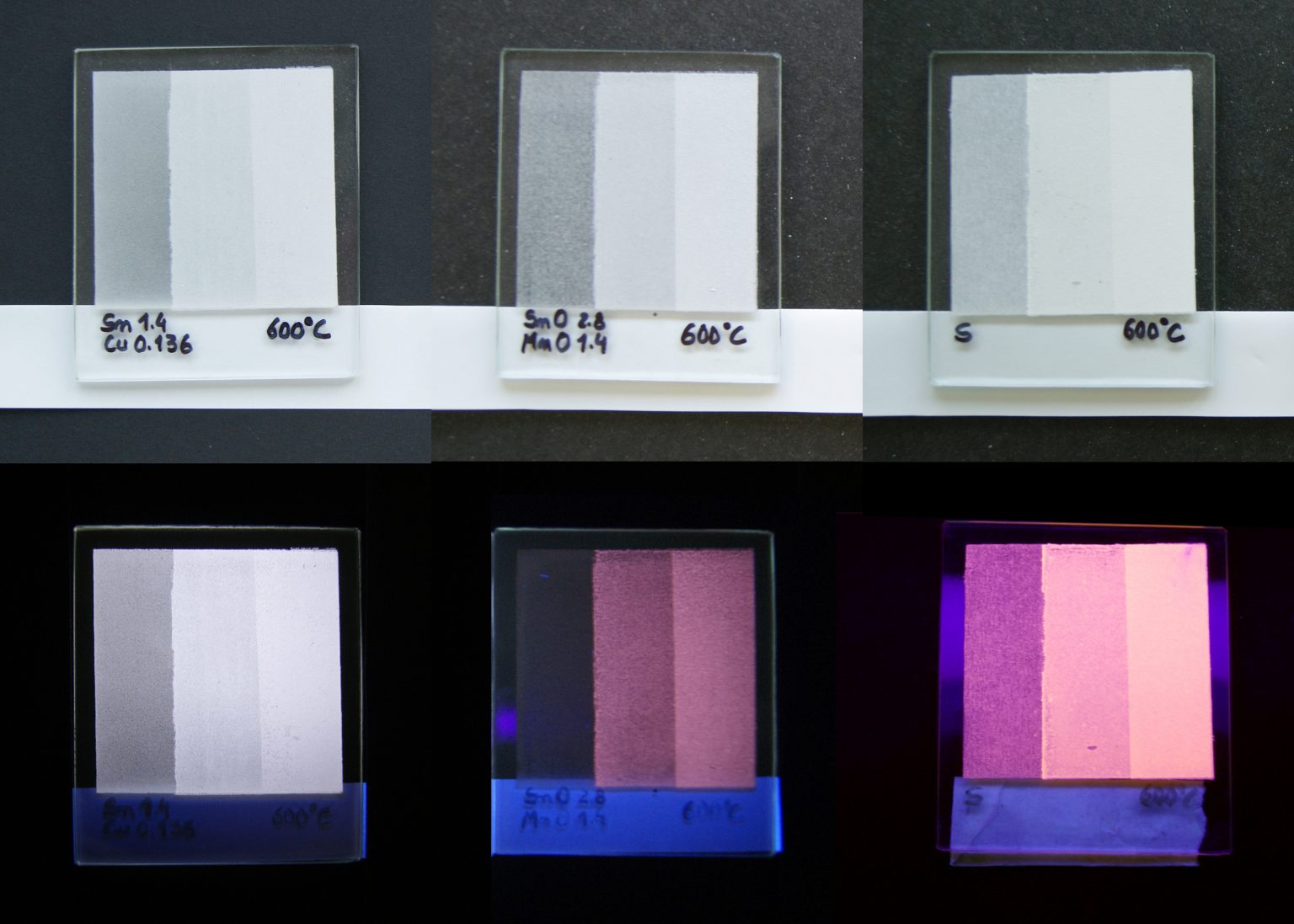Abstract
This research project aims to extend the scope of fine art printing on glass using innovative photoluminescent enamels. This paper demonstrates how these newly created materials, developed by a multidisciplinary team of artists and chemists, can be used as ink to print on glass, both with direct methods and through transfer papers (decals). The methodology used involved studio-based experiments and sampling tests, aiming to verify the ease of adopting identical printing approaches to screen printing, intaglio and photopolymer techniques on paper and glass, and evaluating whether the extent of techniques and respective marks produced were compatible with the application of luminescent enamels. Photoluminescent glass inks have a very attractive aesthetic effect for their ability to change colour and re-emit light after exposure to ultraviolet radiation. This represents a unique opportunity for artists wishing to work on the fields of light, colour, perception and visuality. The unique features of light-emitting images are discussed from a conceptual and aesthetic realm in two installation projects which seek to shape visual experience, combining the visual with the haptic.
References
Addington, M., and Schodek, D. (2005) Smart Materials and New Technologies. Oxford: Elsevier.
Almeida, T., Ruivo, A. and Pires de Matos, A. (2008) Luminescent glasses in art. Journal of Cultural Heritage 9 (2008): e138-e142. doi:10.1016/j. culher.2008.06.002
Armstrong, I. (2008). Victorian Glassworlds. Glass Culture and the Imagination 1830-1880. Oxford: Oxford University Press.
Barker, J.M. (2009) The Tactile Eye: Touch and the Cinematic Experience. Berkley, Los Angeles, London: University of California Press.
Bishop, C. (2019) Installation Art: A Critical History. London: Tate Publishing.
Cherix, C. (2012) Print/out: 20 years in print. New York: Museum of Modern Art.
Clark, R. (eds.) (2011) Phenomenal California Light, Space, Surface. Los Angeles: University of California Press.
Coldwell, P. (2008) Printmaking: A Contemporary Perspective. London: Black Dog Publishing.
Collins, T.; Wei, L.; Young, D.; Louden, S. (2006). Sharon Louden: Character. New York: Neuberger Museum of Art.
Copeland, R. (2000) Blue and White Transfer-Printed Pottery. Buckinghamshire: Shire Publications.
Crary, J. (1992). Techniques of the Observer: on vision and Modernity in the Nineteenth Century. Cambridge: MIT Press.
Crawford, W. (1979) The Keepers of Light: a History and Working Guide to Early Photographic Processes. New York: Morgan and Morgan.
Ferrara, M. and Bengisu, M. (2014) Materials that Change Color. Smart Materials, Inteligent Design. Cham, Heidelberg, New York, Dordrecht, London: Springer.
Frutos, F.J. (2013). From Luminous Pictures to Transparent Photographs: The Evolution of Techniques for Making Magic Lantern Slides. The Magic Lantern Gazette. Volume 25, Number 3 Fall 2013, pp.3-11.
Goethe, J. W. (1840) Theory of Colours. Translated by Charles Lock Eastlake. London: John Murray.
Halbreich, K., Godfrey, M. B., Tattersall, L., & Schaefer, M. (2014). Alibis: Sigmar Polke: Museum of Modern Art.
Hoskins, S. (2004) Inks. London: A&C Black Publishers.
Irigaray, L. (1993) An Ethics of Sexual Difference. London: Althone.
Jay, M. (1988) Scopic Regimes of Modernity. In: Foster, H., ed., (1988) Vision and Visuality, Washington: Bay Press, pp. 3-20.
Laksmanan, A. (2007) Luminescence and Display Phosphors: Phenomena and Applications. New York: Nova Science Publishers.
Laia, C. A. T. and Ruivo, A. (2019) Photoluminescent Glasses and Their Applications. Fluorescence in Industry, 365–88. Springer, Berlin, Heidelberg. https://doi.org/10.1007/4243_2019_12.
Petrie, K. (2006) Glass and Print. London: A&C Black Publishers.
Petrie, K. (2011) Ceramic Transfer Printing. London: A&C Black Publishers.
Ritter, A. (2007) Smart Materials in Architecture, Interior Architecture and Design. Basel, Berlin, Boston: Birkhäuser.
Ronda, C. (2007) Luminescence: From Theory to Applications. Weinheim: Wiley-VCH.
Ruivo, A., Muralha V.S.F; Águas, H., de Matos A.P. and Laia, C.A.T. (2014). Time-Resolved Luminescence Studies of Eu3+ in Soda-Lime Silicate
Glasses. Journal of Quantitative Spectroscopy and Radiative Transfer 134 (February): 29–38. https://doi.org/10.1016/j.jqsrt.2013.10.010
Ruivo, A., Coutinho-Gonzalez, E., Santos M.M., Baekelant, W., Fron, E., Roeffaers, M.B.J., Pina, F., Hofkens, J., and Laia, C.A.T. (2018). Highly Photoluminescent Sulfide Clusters Confined in Zeolites. Journal of Physical Chemistry C. 122:14761-14770. https://doi.org/10.1021/acs. jpcc.8b01247.
Scott, P. (2002) Ceramic and Print. London: A&C Black Publishers.
Shahinpoor, M. (Eds.) (2020). Fundamentals of Smart Materials: Royal Society of Chemistry.
Vasseleu, C. (2002) Textures of Light: Vision and Touch in Irigaray, Levinas and Merleau-Ponty. London and New York: Routledge
Wilson, M. (2012) Discipline Problems and the Ethos of Research. Share Handbook for Artistic Research Education. 203-217. Amsterdam: ELIA.
Wilson, S. (2002) Information Arts. Intersections of art, science and technology. Cambridge: MIT Press.

This work is licensed under a Creative Commons Attribution 4.0 International License.
Copyright (c) 2020 Ana Margarida Rocha , Graciela Machado, Teresa Almeida, César A. T. Laia, Andreia Ruivo
